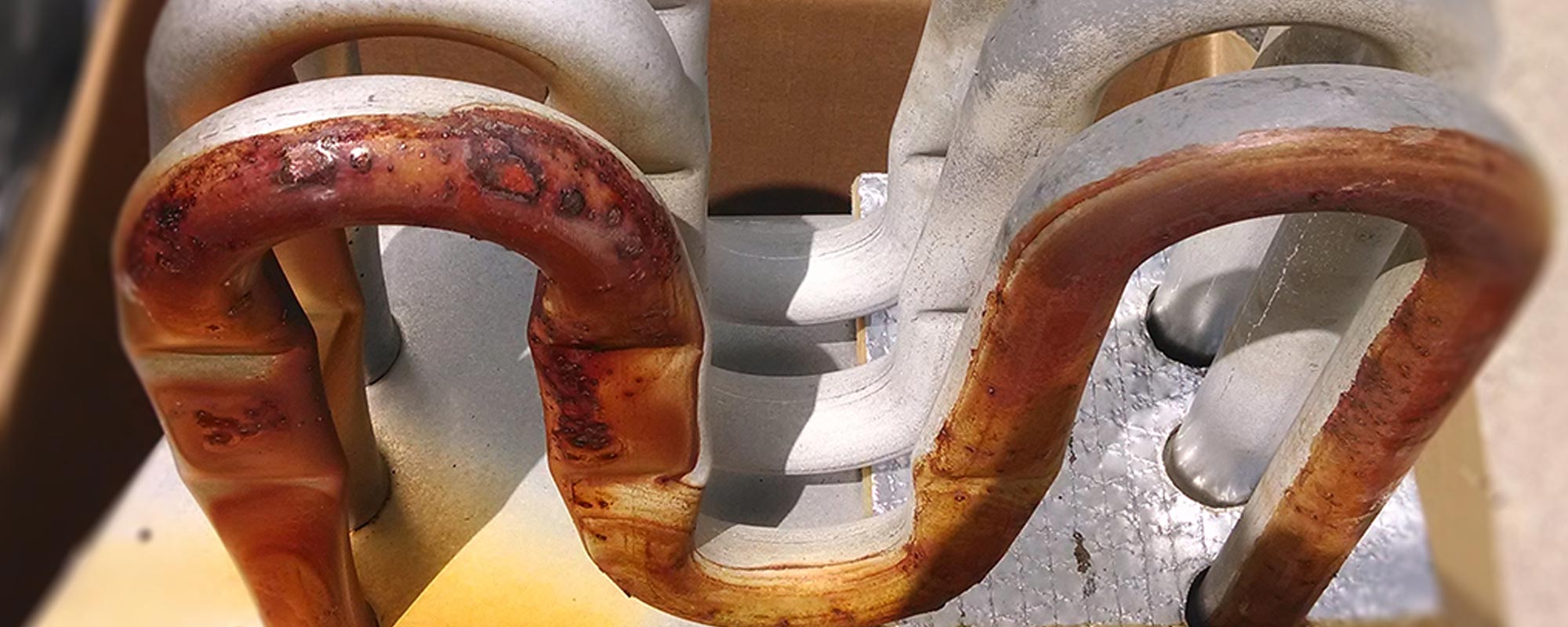The furnace heat exchanger is the most significant furnace component, and its job is to heat the air in the furnace. Heat exchangers typically last ten to twenty years. Cracks and holes sometimes form in heat exchangers over time from regular use. Damaged heat exchangers result in incomplete fuel combustion, a loss in heating power, and potentially deadly carbon monoxide levels.
Recognize the signs of a cracked heat exchanger to decrease the chances of carbon monoxide poisoning and keep your home at a comfortable temperature. Perform a simple test with a match to determine if the heat exchanger is cracked or if the signs point to another issue. Cracked heat exchangers require professional help and, in some cases, a furnace replacement.
Heat Exchanger HVAC Definition
Heat exchangers are used in heating, cooling, refrigeration, and other applications to transfer heat from one place to another. A forced-air furnace uses an HVAC heat exchanger to move heat from the furnace’s burner to the air. The warmed air is then blown through the ducts and registers.
A gas furnace heat exchanger operates in a basic manner. The furnace’s burner provides heat by burning natural gas or propane fuel. The heat exchanger’s metal absorbs heat directly from the burner, but warmth is also extracted from the exhaust as it travels through the heat exchanger’s metal tubes. After traveling through the heat exchanger’s lines, the exhaust is vented outside the house through the flue. The heat exchanger’s design allows heat to be extracted from the flue gasses without emitting harmful exhaust into the home.
The warmth absorbed by the heat exchanger’s metal transfers to the cold air returning from the ducts and circulating over the heat exchanger. A fan blows the heated air throughout the house’s ductwork and vents.
Older furnaces have one primary heat exchanger. Newer condensing furnaces have primary and secondary heat exchangers to extract additional heat from the flue gasses for greater efficiency.

Find the Ideal Furnace for Your Home: View Our Products
Primary Heat Exchanger
The primary heat exchanger is close to the burner where the flue gasses are hottest. Primary heat exchangers are tubular and usually made of aluminized steel because the material conducts heat well. Due to their proximity to the burners, primary heat exchangers are subject to more stress and are more likely to crack than secondary heat exchangers. Furnaces that are 70-80% efficient have only a primary heat exchanger.
Secondary Heat Exchanger
High-efficiency furnaces, which are 90% efficient or better, have primary and secondary heat exchangers. Flue gasses enter the secondary heat exchanger after traveling through the primary heat exchanger. Secondary heat exchangers have stainless or coated steel fins that can withstand heat, moisture, and acid.
The gasses condense in the secondary heat exchanger as the remaining heat is transferred and the gasses cool. Water vapor forms and combines with carbon dioxide to create carbonic acid. The resulting condensation drains from the furnace through the condensate line. High-efficiency furnaces are sometimes called condensing furnaces because the secondary heat exchanger produces condensation.
Where is the furnace heat exchanger?
The heat exchanger is located near the combustion chamber. The primary heat exchanger begins at the burner assembly and leads to the flue vent. In a high-efficiency furnace, the primary heat exchanger leads to the secondary heat exchanger, which leads to the flue vent.
Some heat exchangers can be inspected visually; others require a special camera that can be fed through the heat exchanger to check inaccessible areas.
8 Signs of a Cracked Furnace Heat Exchanger
The heat exchanger is a critical component of a furnace. If it cracks, there will be noticeable symptoms. The following signs don’t guarantee the heat exchanger is cracked, however. Some other furnace issues share the same characteristics as a cracked heat exchanger.

Find the Ideal Furnace for Your Home: View Our Products
Heat Exchanger Match Test
The "match test" is one way to locate heat exchanger cracks. The airflow from the crevasse puts out the match's flame.
- Adjust the thermostat's settings. Move the system switch from "heat" to "off" and the fan switch from "auto" to "on." You don't want the heat to be on, but you do want the fan to circulate air through the system,
- Turn off the gas supply line to the furnace as a precaution. Remove the furnace's access panel.
- Light a match, and hold it in front of each heat exchanger cell, one at a time.
- Observe the match's flame. A flickering flame or a flame extinguished indicates that the fan's air is entering the heat exchanger through a crack.
Can Furnace Heat Exchangers Be Replaced?
Heat exchangers cannot be repaired, but they can be replaced. Replacing a heat exchanger is costly and must be performed by a professional—the total cost of replacing a heat exchanger averages $1,000 to $2,000.
According to HomeAdvisor, the replacement process can take five to eight hours. HVAC companies typically charge $75 to $125 an hour for labor. A primary heat exchanger part costs $350 to $850; a secondary heat exchanger part costs $300 to $800.
Most furnaces come with ten- to twenty-year parts warranties that cover the cost of new heat exchangers. These warranties do not cover labor costs, ranging from $400 to $600.
Depending on the age of your furnace and the extent of the repairs, replacing the entire furnace might be a more cost-effective option. Gas furnaces typically last ten to twenty years and cost an average of $4,500 to $6,000, including installation.
Conclusion
If you suspect your furnace has a cracked heat exchanger, schedule an appointment with an HVAC technician. Replacing a heat exchanger is not a DIY job, and it’s not something you should put off for later. A cracked heat exchanger reduces your furnace’s efficiency and, more importantly, poses health risks. Please turn off your heating system, and don’t turn it back on until a professional has inspected it and deemed it safe.







